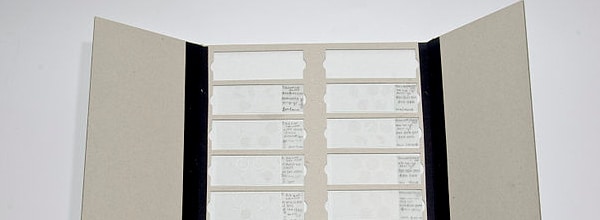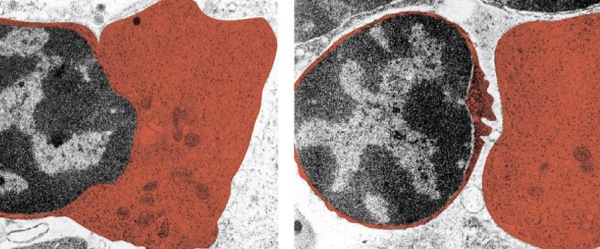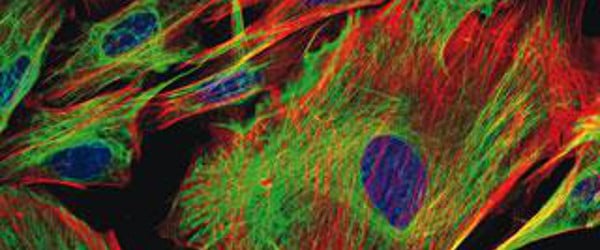Dichroic Mirror/Filter
This is a semi-reflective filter which can also be referred to as ‘dichromatic beam splitter’. Unlike the Longpass filters which absorb light which is not transmitted (see Part 1 of the Glossary), these filters reflect light at lower wavelengths and transmit light at wavelengths above the ‘cut-on’ wavelength. As beam splitters, they are essentially filters that separate excitation from emission light in many types of widefield fluorescence and confocal microscopes. Dichroic filters with very complex spectral properties are available to filter more than one wavelength band simultaneously.
For all optical filters: the cut on/off properties describe a slope of light transmission. The steeper the slope, the sharper the spectral separation. Therefore, the wavelength(s) given to specify each filter refers to the wavelength at 50% of the maximum transmission.
Digital Cameras
These are electronic devices used on a range of microscopes to record complete magnified images. They contain an image chip, which is a square matrix of light-sensitive elements (capacitors), or pixels that convert photons into photoelectrons, which can be subsequently recorded and quantified. The photon count per pixel is proportional to the intensity that is shown in the resulting digital image. For higher sensitivity and more efficient read-out, these cameras come as charge-couple devices (CCD). This means that each capacitor on the chip is coupled to a charge storage region, which accumulates the charges/photoelectrons and is connected to an amplifier for read-out and quantitation. To further increase sensitivity, each tiny capacitor has a built-in amplification, which converts a single photoelectron into several. These cameras are called ‘Electron Multiplied CCD’ (EMCCD) cameras. Acquisition speed of these cameras is usually limited by the read-out rate of the chip. For faster read-out rates there have been recent improvements of complementary metal oxide semiconductor (CMOS) cameras for microscopy.
Important parameters of a digital camera to consider are: chip size (pixel number, with 512 x 512 and 1024 x 1024 being the most commonly used formats), pixel size (area of each photo-sensitive capacitor, between 6 x 6 and 16 x 16 microns are common formats), quantum efficiency (efficiency to convert photons into photoelectrons) and read-out speed and noise.
Enjoying this article? Get hard-won lab wisdom like this delivered to your inbox 3x a week.

Join over 65,000 fellow researchers saving time, reducing stress, and seeing their experiments succeed. Unsubscribe anytime.
Next issue goes out tomorrow; don’t miss it.
Photomultiplier Tubes
PMTs are highly sensitive devices used to quantify photon fluxes. A photocathode at the entry of the device converts all photons into electrons, which are deflected towards the anode of the tube via an amplification dynode. The dynode is built from several elements which allow adjustable, stepwise, exponential amplification of each converted photon, depending on the voltage (‘PMT Gain’) applied to the tube. Unlike a digital camera, the PMT does not record any spatial information. Therefore, it is typically used on point scanning microscopes, where it measures the photon flux coming from each scanned point (pixel) and records it together with the XY-coordinate of the pixel. The recorded photon count in each pixel is proportional to the pixel intensity in the resulting image.
Confocality
‘Confocal’ means ‘having the same focus’. In the context of light microscopy it defines all image information that comes from the same focal plane. In a standard widefield microscope, this confocal information mixes with the out-of-focus image information which is recorded at the same time, and which leads to a blurred image. By spatially filtering out large proportions of the out-of-focus light, e.g. by installing a pinhole in the back-focal plane of the microscope, the resulting confocal microscope provides confocality of the image, meaning that most of the image information is coming from the focal plane in the sample.
We hope you learned more about the terminology we take for granted as biologists and microscopists. However, please let us know if you would like us to expand the glossary.
You made it to the end—nice work! If you’re the kind of scientist who likes figuring things out without wasting half a day on trial and error, you’ll love our newsletter. Get 3 quick reads a week, packed with hard-won lab wisdom. Join FREE here.








